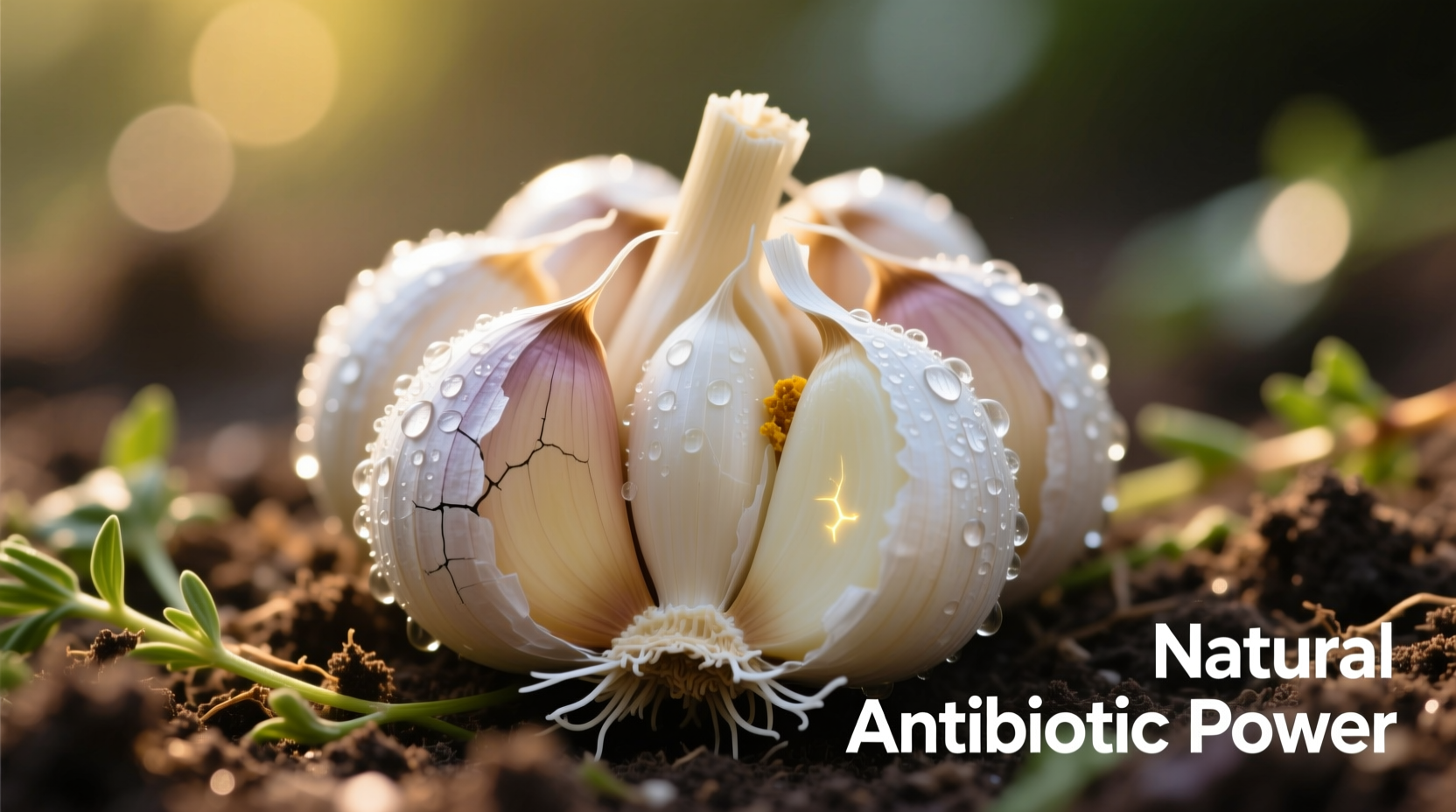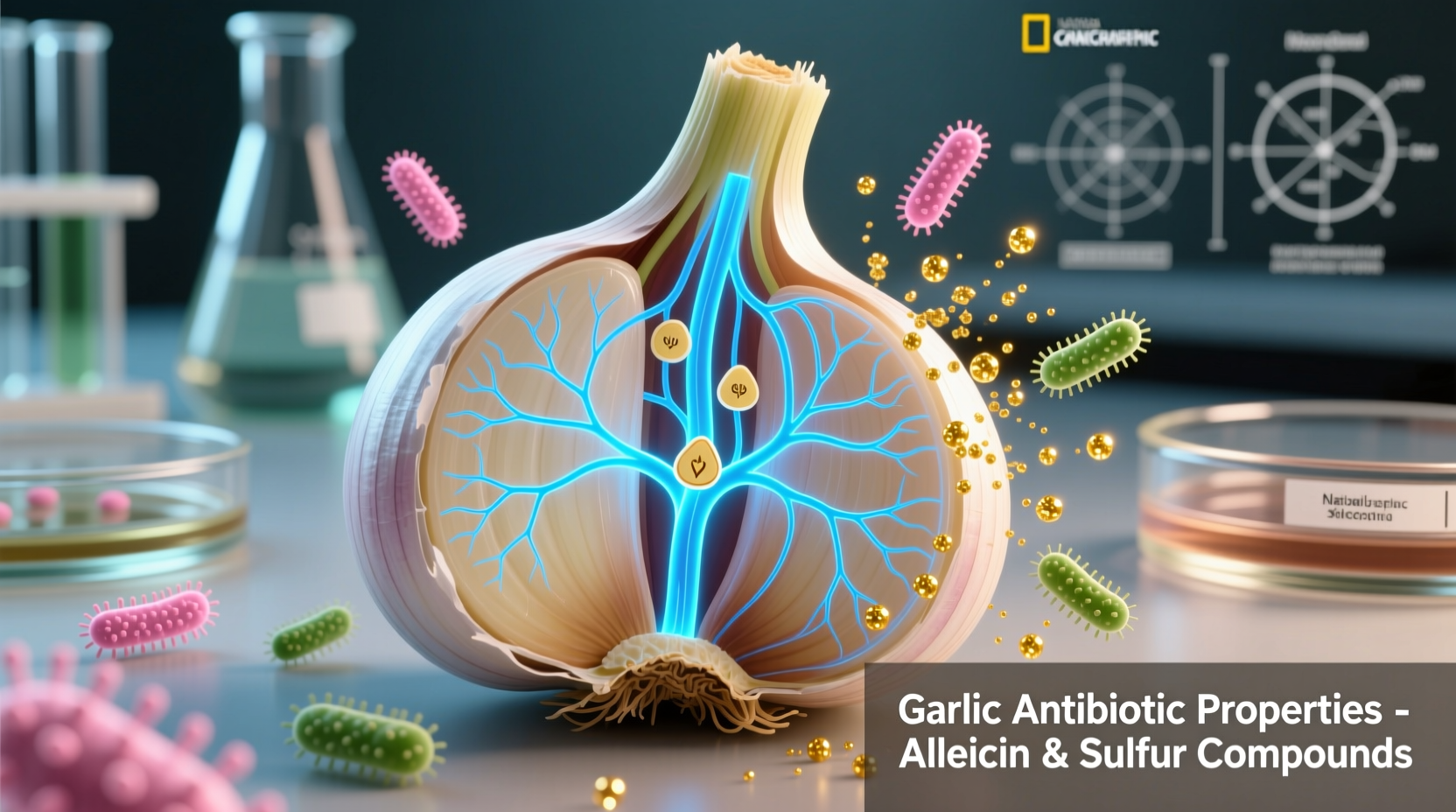Yes, garlic possesses natural antibiotic properties primarily due to allicin, a compound formed when garlic is crushed or chopped. Scientific studies confirm garlic's effectiveness against certain bacteria including E. coli and Staphylococcus aureus, though it's not a replacement for prescription antibiotics in treating serious infections.
For centuries, cultures worldwide have relied on garlic as a natural remedy for infections. Modern science now validates these traditional uses while clarifying important limitations. This article separates evidence-based facts from popular myths about garlic's antibiotic capabilities, helping you understand when it might provide supportive benefits and when professional medical treatment is essential.
The Active Compound: How Garlic Fights Bacteria
When you crush or chop fresh garlic, an enzyme called alliinase converts alliin into allicin—the primary compound responsible for garlic's antimicrobial effects. This reaction requires moisture and reaches peak potency after about 10 minutes. Allicin works by disrupting bacterial enzymes and cell functions through several mechanisms:
- Inhibiting sulfur-containing enzymes essential for bacterial metabolism
- Disrupting biofilm formation that protects bacterial colonies
- Interfering with bacterial cell division processes
Unlike prescription antibiotics that typically target specific bacterial mechanisms, allicin's multi-target approach makes it effective against a broader range of microorganisms while potentially reducing the risk of resistance development.

Scientific Evidence: What Research Shows
Let's examine the timeline of key discoveries that established garlic's antimicrobial properties:
| Year | Key Research Finding | Source |
|---|---|---|
| 1944 | First isolation of allicin and documentation of its antibacterial effects | Cavallito & Bailey, Journal of the American Chemical Society |
| 1987 | Confirmation of effectiveness against antibiotic-resistant bacteria strains | Ankri & Mirelman, Antimicrobial Agents and Chemotherapy |
| 2016 | Meta-analysis confirming garlic's inhibitory effects on 25+ bacterial strains | Nation Institutes of Health comprehensive review |
| 2022 | Study demonstrating enhanced effectiveness when combined with conventional antibiotics | Journal of Antimicrobial Chemotherapy |
Garlic vs. Prescription Antibiotics: Understanding the Differences
While garlic shows promising antimicrobial activity, it's crucial to understand its limitations compared to medical antibiotics. This comparison highlights key differences:
| Characteristic | Garlic (Allicin) | Prescription Antibiotics |
|---|---|---|
| Concentration Control | Variable (depends on preparation) | Precise therapeutic dosing |
| Broad-Spectrum Effectiveness | Moderate (25+ bacterial strains) | High (targeted specific bacteria) |
| Clinical Testing | Limited human trials | Rigorous FDA-approved testing |
| Regulatory Approval | Not approved for infection treatment | Approved for specific infections |
| Resistance Development | Lower risk observed in studies | Significant concern with misuse |
Practical Applications with Realistic Expectations
Understanding garlic's context-specific usefulness helps avoid dangerous misconceptions. Research from the National Center for Complementary and Integrative Health indicates garlic may provide supportive benefits in these specific scenarios:
- Mild upper respiratory infections: May reduce duration and severity of common cold symptoms when used preventatively
- Skin surface applications: Crushed garlic shows effectiveness against certain topical bacterial and fungal infections
- Digestive support: May help maintain healthy gut flora balance when consumed regularly
- Antibiotic adjuvant: Emerging research suggests potential to enhance effectiveness of certain prescription antibiotics
However, garlic cannot treat serious bacterial infections like pneumonia, strep throat, or urinary tract infections that require prescription antibiotics. The Centers for Disease Control emphasizes that delaying proper antibiotic treatment for serious infections can lead to dangerous complications.
Maximizing Garlic's Benefits: Preparation Matters
The antimicrobial potency of garlic depends entirely on proper preparation. To maximize allicin production:
- Crush or chop fresh garlic cloves (pre-minced garlic lacks potency)
- Allow 10 minutes exposure to air before cooking or consuming
- Avoid high-heat cooking immediately after preparation (destroys allicin)
- Consume raw for maximum effect (add to dressings, dips, or smoothies)
For therapeutic purposes, research suggests consuming 2-5 grams of fresh, properly prepared garlic daily (approximately 1-2 cloves). Note that aged garlic extracts and cooked garlic have significantly reduced antimicrobial activity compared to raw, freshly prepared garlic.
Safety Considerations and Limitations
While generally safe as a food ingredient, therapeutic garlic use requires caution in specific situations:
- Medication interactions: Garlic may enhance blood-thinning medications like warfarin
- Surgical considerations: Discontinue high-dose garlic at least 1 week before surgery
- Digestive sensitivity: Large amounts may cause heartburn or digestive upset
- Pregnancy: Moderate culinary use is safe, but therapeutic doses require medical consultation
The National Library of Medicine notes that garlic supplements vary widely in potency and quality, making fresh garlic the most reliable source for consistent allicin content. Always consult your healthcare provider before using garlic therapeutically, especially if managing health conditions or taking medications.
Conclusion: Evidence-Based Perspective
Garlic's natural antibiotic properties represent a fascinating intersection of traditional wisdom and modern science. While research confirms its effectiveness against certain bacteria, it's essential to maintain realistic expectations about its capabilities. Garlic works best as a supportive element in a healthy lifestyle rather than a replacement for medical treatment. When properly prepared and used with awareness of its limitations, garlic can contribute to your overall wellness strategy while honoring centuries of traditional use validated by contemporary research.











 浙公网安备
33010002000092号
浙公网安备
33010002000092号 浙B2-20120091-4
浙B2-20120091-4